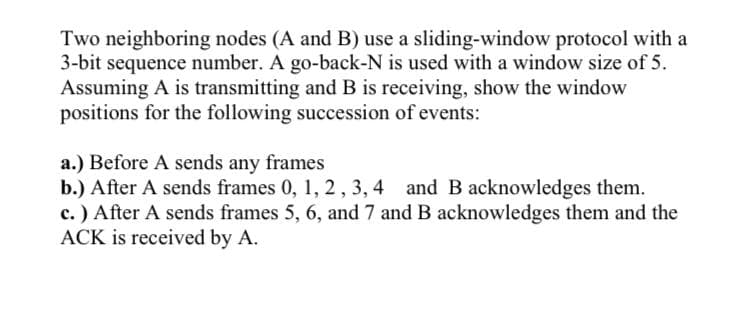Two neighboring nodes ( A and B ) use a sliding - window protocol with a 3 - bit sequence number . A go - back - N is used with a window size of 5 . Assuming A is transmitting and B is receiving , show the window positions for the following succession of events : a . ) Before A sends any frames b . ) After A sends frames 0 , 1 , 2 , 3 , 4 and B acknowledges them . c . ) After A sends frames 5 , 6 , and 7 and B acknowledges them and the ACK is received by A.
Two neighboring nodes ( A and B ) use a sliding - window protocol with a 3 - bit sequence number . A go - back - N is used with a window size of 5 . Assuming A is transmitting and B is receiving , show the window positions for the following succession of events : a . ) Before A sends any frames b . ) After A sends frames 0 , 1 , 2 , 3 , 4 and B acknowledges them . c . ) After A sends frames 5 , 6 , and 7 and B acknowledges them and the ACK is received by A.
Computer Networking: A Top-Down Approach (7th Edition)
7th Edition
ISBN:9780133594140
Author:James Kurose, Keith Ross
Publisher:James Kurose, Keith Ross
Chapter1: Computer Networks And The Internet
Section: Chapter Questions
Problem R1RQ: What is the difference between a host and an end system? List several different types of end...
Related questions
Question
Two neighboring nodes ( A and B ) use a sliding - window protocol with a 3 - bit sequence number . A go - back - N is used with a window size of 5 . Assuming A is transmitting and B is receiving , show the window positions for the following succession of events : a . ) Before A sends any frames b . ) After A sends frames 0 , 1 , 2 , 3 , 4 and B acknowledges them . c . ) After A sends frames 5 , 6 , and 7 and B acknowledges them and the ACK is received by A.

Transcribed Image Text:Two neighboring nodes (A and B) use a sliding-window protocol with a
3-bit sequence number. A go-back-N is used with a window size of 5.
Assuming A is transmitting and B is receiving, show the window
positions for the following succession of events:
a.) Before A sends any frames
b.) After A sends frames 0, 1, 2,3, 4 and B acknowledges them.
c.) After A sends frames 5, 6, and 7 and B acknowledges them and the
ACK is received by A.
Expert Solution
This question has been solved!
Explore an expertly crafted, step-by-step solution for a thorough understanding of key concepts.
This is a popular solution!
Trending now
This is a popular solution!
Step by step
Solved in 2 steps with 2 images

Recommended textbooks for you

Computer Networking: A Top-Down Approach (7th Edi…
Computer Engineering
ISBN:
9780133594140
Author:
James Kurose, Keith Ross
Publisher:
PEARSON

Computer Organization and Design MIPS Edition, Fi…
Computer Engineering
ISBN:
9780124077263
Author:
David A. Patterson, John L. Hennessy
Publisher:
Elsevier Science

Network+ Guide to Networks (MindTap Course List)
Computer Engineering
ISBN:
9781337569330
Author:
Jill West, Tamara Dean, Jean Andrews
Publisher:
Cengage Learning

Computer Networking: A Top-Down Approach (7th Edi…
Computer Engineering
ISBN:
9780133594140
Author:
James Kurose, Keith Ross
Publisher:
PEARSON

Computer Organization and Design MIPS Edition, Fi…
Computer Engineering
ISBN:
9780124077263
Author:
David A. Patterson, John L. Hennessy
Publisher:
Elsevier Science

Network+ Guide to Networks (MindTap Course List)
Computer Engineering
ISBN:
9781337569330
Author:
Jill West, Tamara Dean, Jean Andrews
Publisher:
Cengage Learning

Concepts of Database Management
Computer Engineering
ISBN:
9781337093422
Author:
Joy L. Starks, Philip J. Pratt, Mary Z. Last
Publisher:
Cengage Learning

Prelude to Programming
Computer Engineering
ISBN:
9780133750423
Author:
VENIT, Stewart
Publisher:
Pearson Education

Sc Business Data Communications and Networking, T…
Computer Engineering
ISBN:
9781119368830
Author:
FITZGERALD
Publisher:
WILEY